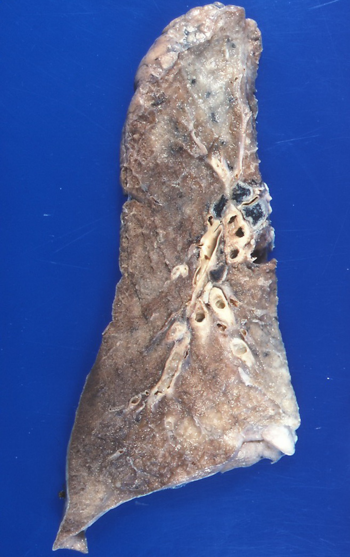Autopsy
In health care, an autopsy is a "postmortem examination of the body."[1]

A formalin-perfused human lung obtained at autopsy, showing anthracosis of hilar lymph nodes but otherwise normal appearance.
The equivalent procedure is called a necropsy in veterinary medicine.
Benefits
Analysis of a large number of autopsies can provide insight into lethal diseases that are difficult to diagnose.[2][3][4] For example, a study of autopsies among patients receiving mechanical ventilation in the intensive care, an concluded about overlooked diagnoses "abdominal pathologic conditions--abscesses, bowel perforations, or infarction--were as frequent as pulmonary emboli as a cause of class I errors. While patients with abdominal pathologic conditions generally complained of abdominal pain, results of examination of the abdomen were considered unremarkable in most patients, and the symptom was not pursued." [5]
References
- ↑ Anonymous (2024), term (English). Medical Subject Headings. U.S. National Library of Medicine.
- ↑ Goldman L, Sayson R, Robbins S, Cohn LH, Bettmann M, Weisberg M (1983). "The value of the autopsy in three medical eras". N. Engl. J. Med. 308 (17): 1000–5. PMID 6835306. [e]
- ↑ Shojania KG, Burton EC, McDonald KM, Goldman L (2003). "Changes in rates of autopsy-detected diagnostic errors over time: a systematic review". JAMA 289 (21): 2849–56. DOI:10.1001/jama.289.21.2849. PMID 12783916. Research Blogging.
- ↑ Sonderegger-Iseli K, Burger S, Muntwyler J, Salomon F (2000). "Diagnostic errors in three medical eras: a necropsy study". Lancet 355 (9220): 2027–31. PMID 10885353. [e]
- ↑ Papadakis MA, Mangione CM, Lee KK, Kristof M (1991). "Treatable abdominal pathologic conditions and unsuspected malignant neoplasms at autopsy in veterans who received mechanical ventilation". JAMA 265 (7): 885–7. PMID 1992186. [e]